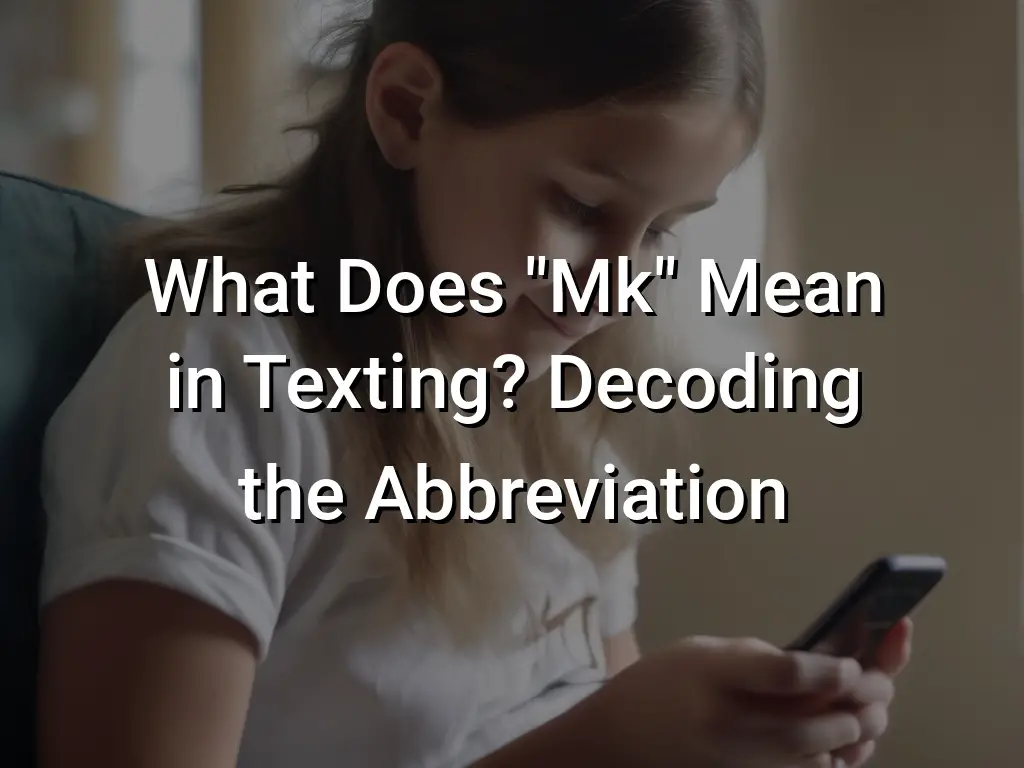What Does “Mk” Mean in Texting? Decoding the Abbreviation

Have you ever received a text message with the abbreviation “Mk” and wondered what it means? Well, you’re not alone! Texting has its own language, filled with abbreviations and acronyms, and “Mk” is one of them.
In this article, we’ll decode the meaning of “Mk” in texting and explore its various interpretations and usage. Whether you’re curious about the origins of this abbreviation or just want to stay up-to-date on the latest texting lingo, keep reading to uncover the meaning of “Mk” and how it’s commonly used in conversations.
What does “Mk” stand for in texting?
“Mk” is a common abbreviation used in texting and online messaging. It is derived from the word “okay” and is often used as a shorthand way to indicate agreement or acknowledgement. When someone responds with “Mk” in a conversation, it means that they have understood the message or are accepting of what has been said.
Here are a few examples of how “Mk” can be used in text messages:
- Person A: Are you free to meet up later? Person B: Mk, what time and where?
- Person A: I’m running a bit late, sorry! Person B: No problem, mk. See you soon.
- Person A: The movie starts at 7 pm. Person B: Mk, I’ll be there on time.
In these examples, “Mk” is used as a concise way to indicate agreement, acceptance, or understanding without needing to type out the full word “okay”.
Next, we will explore the different interpretations and contexts in which “Mk” is commonly used in text messages.
Different Interpretations of “Mk” in Text Messages
Response Confirmation
In some contexts, “Mk” is used as a short form of “OK” or “okay” to acknowledge or confirm a message. It is a quick and informal way to indicate understanding or agreement.
Lack of Interest or Enthusiasm
In other situations, “Mk” can be interpreted as a dismissive or uninterested response. It may convey a lack of engagement or enthusiasm in the conversation.
Agreement without Enthusiasm
Similarly, “Mk” can also be seen as a neutral response indicating agreement without much excitement or emphasis. It may be used when the person is not fully invested in the topic or conversation.
Shortened “My Mistake”
Another possible interpretation of “Mk” is the abbreviation of “my mistake.” It can be used to acknowledge one’s own error or admission of fault.
Overall, the interpretation of “Mk” in text messages can vary depending on the context and the sender’s intentions. It is important to consider the overall tone of the conversation and the relationship between the individuals involved to understand the intended meaning.
Common Contexts in Which “Mk” is Used
Texting and Instant Messaging
One of the most common contexts in which “Mk” is used is in texting and instant messaging conversations. It is often used as a shortened version of “okay” or “alright” to indicate agreement or understanding.
Online Gaming
In online gaming communities, “Mk” is frequently used as an abbreviation for “Mark,” typically used to denote a specific target or objective in the game. Players may use phrases such as “Find the Mk” or “Kill the Mk” to coordinate gameplay strategies.
Slang and Informal Language
“Mk” has also become a part of slang and informal language, especially in certain online communities. It can be used to acknowledge or respond to someone’s statement, similar to saying “got it” or “noted.” It is often used in a casual or sarcastic manner.
Branding and Marketing
“Mk” is sometimes used in branding and marketing, particularly in the fashion industry. It can be seen as an abbreviation or shorthand for “Michael Kors,” a well-known fashion brand. In this context, “Mk” may refer to products or promotions associated with the brand.
These are some of the common contexts in which “Mk” is used in various forms of communication. The interpretation of “Mk” can vary depending on the context and the individuals involved in the conversation.
The Origins and Popular Usage of “Mk”
The abbreviation “Mk” has become a common texting shorthand, often used in place of the word “okay” or “ok.” While it may seem like a recent development in the age of smartphones and messaging apps, the origins of “Mk” can actually be traced back to early internet chat rooms and instant messaging platforms.
The abbreviation “Mk” likely emerged as a way to quickly and efficiently convey agreement or acknowledgment in written conversations. Its brevity and simplicity made it an ideal choice for expressing agreement without the need for typing out the entire word “okay.”
Over time, “Mk” has gained widespread popularity and is now commonly used in various online and texting contexts. It has become a convenient shorthand for expressing consent, understanding, or confirming plans.
In addition to its usage in casual conversations, “Mk” has also become a part of popular culture. It is frequently used in memes, social media posts, and even song lyrics as a way to convey agreement or compliance in a lighthearted or ironic manner.
It’s important to note that the interpretation of “Mk” can vary depending on the context and the relationship between the individuals involved in the conversation. While it is generally used to indicate agreement or acknowledgment, the precise meaning may differ from person to person. It’s always best to consider the specific context and tone of the conversation in order to accurately understand the intended meaning of “Mk.”
Conclusion
Overall, “Mk” is a widely used shorthand in text messages, often standing for “okay” or “message received.” However, it’s important to note that text messaging abbreviations can often have different interpretations depending on the context and the relationship between the sender and recipient.
While “Mk” may be commonly used, it’s always best to clarify the meaning with the person you’re communicating with if there’s any confusion. The origins of “Mk” are not entirely clear, but it has become a popular choice among texters and is likely to continue being used in the future.